danbricklin.com/log
|
||
|
|
Starting November 3, 1999
eJournal vs. eColumn, Saving the whiteboard, Much fuss about the DNS (and IP), Rusty pipes, Accident reports, Bang!, New PR team, After we're gone, Trademark essay standalone
3-5Nov99
1999-11-3.htm
|
|
Friday, November 5, 1999
eJournal vs. eColumn: Phone calls from a friend
Dan Gillmor posted his first print column in the San Jose Mercury News created from his eJournal daily log. I love reading his eJournal. I love his columns. I didn't like his column quoting his eJournal.
I've been reading weblogs for quite a while. It's only since I started writing one myself and watched Dan start his that I've begun trying to understand the genre of online journals. Here are some thoughts as I work on expressing what I'm learning. (For those of you who already know this stuff, I hope you enjoy watching me go through the process.)
I think the eJournal makes Dan have a different relationship with his readers than a standalone essay or article. The eJournal is much more informal and intimate. It feels like a phone call from a friend on a trip. It's even better and more informal when he peppers it with photos. These pictures are "snapshots", not works of art. There is also the "ongoing, as it happens" nature of the eJournal. I loved the part where he said "Look who's in Hong Kong" and showed a snapshot he took of Scott McNealy with a story to come later. We shared his surprise. It was as if we were talking on a cellphone and he said "Guess who's here...Got to go: I'll call back later!" This is not how standalone essays are usually written.
Reading his November 4th column where he excerpts his eJournal without pictures (at least on-line) felt like reading a transcript of a movie I hadn't seen: Mixing communication styles. It lost the intimate feeling without gaining the well-crafted, "tying it all together for easy understanding" feeling of his essays. Real life is not filtered and ordered for understanding or skimming. Good essays are.
Dan Gillmor gives us a great example to examine since he is creating both genres (eJournal and regular print column) simultaneously. He is also quite good at both, which will help control the experiment better.
Saving the whiteboard
When we first started Trellix Corporation a few years ago, I bought a digital camera for experimentation. I hoped to use it to archive our designs on the whiteboard. Here's an old example, showing the entire frame and a small cropped portion of one of those photos at 24% and 100% magnification, respectively, taken in 1996:
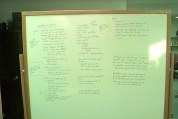  Full whiteboard, 24% and 100%, in 1996
I had to shoot it many times, since the camera only had 756x504 pixel resolution. I took one shot to show the whole thing, and then one third or more at a time:
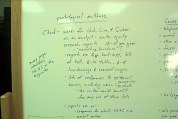  Closeup, 24% and 100%, in 1996
This didn't prove very popular, and we rarely used this technique. A lot of time went into transcribing whiteboards.
Now, thanks to today's 2 megapixel (1600x1200) cameras, I've started taking whiteboard pictures again. Here's one I took yesterday (in 1999):
  Full whiteboard, 5% and 100%, in 1999
Digital cameras are quite useful. If you are a software developer or web site creator and don't have one, you are missing an important tool. There are many uses for digital cameras, and as they get better more uses will become possible, as I show here.
Much fuss about the DNS (and IP)
Bob Frankston and David Reed have posted an essay entitled "Much fuss about the DNS (and IP)" that is a nice introduction to the history of the Domain Name System, IP addresses, and the scarcity problems for both.
For those that don't know David, you may want to check out his web site. Among other things, he was a contributor to the early protocol designs for the Internet, including parts of TCP/IP. (Owning "reed.com" alone shows you he must have been somewhat early.) One important paper he co-authored is "End-to-end arguments in system design". The paper shows how "...functions placed at low levels of a system may be redundant or of little value when compared with the cost of providing them at that low level. Examples discussed in the paper include bit error recovery, security using encryption, duplicate message suppression, recovery from system crashes, and delivery acknowledgement".
Thursday, November 4, 1999
Rusty pipes
I mentioned yesterday about our Internet connection at work being down a lot. I read on Dave Winer's site that he's had problems recently, too (different ISPs, though). At Agenda 2000, Bob Metcalfe kept referring to a prediction of his about an Internet meltdown November 8th. Early tremors? I hope not.
If you'd like to read it, I've posted a copy of the letter our ISP sent us. (No names, since I don't know the details.) As Will Blanchard, a co-worker, asked at lunch: "I thought the Internet could withstand a nuclear blast. How come one piece of hardware in NY can bring us all down?" (For the geographically challenged, we're more than 200 miles from New York. There's a lot of hardware between here and New York City to make things redundant.)
My insurance agent loved my simple "accident report" on this web site. He wanted to put it in his filing to the insurance carrier, but I think he was told they didn't have Internet access so it wouldn't help. (I told him I have much higher-res versions, and ones showing more details like the license plate and person, but that those were not for the web...)
Wednesday, November 3, 1999
Bang!
Driving home today someone backed into my car while I was waiting to make a right turn. Quite weird to realize there is suddenly a car coming out of a direction cars never come from. Nobody hurt, it was at low speed. Now I have to get it fixed. What a pain. I had the camera so I documented it a bit:
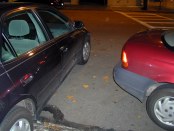  My car is the gray one
New PR team
Today I was introduced to the new public relations team that I will be working with at Trellix Corporation. They are from PAN Communications in Andover, MA. (Don't go to their site if you have a slow dial-up line...) The first meeting with a PR firm is where you meet the whole team, including the senior people whom you rarely work with. They also dress up real nice, ties, pearls, etc. For the web, though, they'd like to appear more like themselves (for this picture Philip Nardone, president, threw his tie over his shoulder and off came reading glasses, etc.):
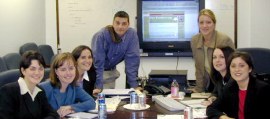 PR team in front of screen with this web site
They were not used to being included, via the web, in the PR. One of the things the intimacy of the web brings is showing more details and letting more people's work be understood.
I talked with them about one of their missions: Explaining to everyday people that the web is a communications medium everybody should use to keep in touch with friends and loved ones (like I discuss on the webphotojournals.com web site). Donna Caturano (standing on the right), now Donna Caturano Kish, really related to what we were saying, since she got reactions to the wedding web site her new husband put up that were similar to those I got to one I created for a relative. Not "You are so cool", but rather: "Bless you for sharing that event with me that I missed" or "I just wanted to tell you how touching and special the website you created was. It certainly captured the love and spirit of the entire weekend".
I mention stuff about PR since some of my readers here are members of the press and PR people are a part of their lives (for good or bad). Also notice the intertwining of a PR message with an item about PR people and my life...it was too much fun to pass up! And, after I posted it, I got to show it to them -- the meeting was still going on -- and watch them react as they got a taste of the double-edged sword of PR a little closer to home: My crack about slow modems and their web site got groans.
After we're gone
My connections to the Internet have been quite flakey the last few days. My cable modem's been quite slow in the evening (I guess the loop I'm on is popular). Our email was out at work over the weekend a lot. And for hours at a time our main connection to the Internet at Trellix was out. Something about "routers in New York" having problems.
On the way to work yesterday I passed by some digging in the street and stopped. Here's what I saw:
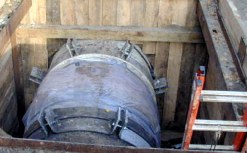 Water main from 1929
I asked what was going on. It was a water main. Made of steel and originally built in 1929, they were doing periodic maintenance cleaning it out. Unlike a water main I remember in my town that broke a while back and that had outlived its intended life by many decades, they said this one was still OK.
What a contrast. Here we were building infrastructure for our electronic future and we're lucky if some parts last 6 months. We fight extending the IP address space from an artificial limit on number of servers yet we hope to wire everything with a clocktick (IPv4 vs. IPv6). We're thinking about letting there be only one use for the word "fidelity", and the use will be for money (trademarks and domain names as I described November 1).
We should learn from the Y2K situation that computing has become the pervasive structure on which we are building more and more of society. Unlike the old days when we assumed everything we built out of computers would be continually replaced, we now have to live up to the fact that some things may have to be good enough to last for the rest of our lives and beyond. The people who built that water main 70 years ago are probably in their 90's or resting in peace knowing their work was done well.
Trademark essay standalone
I've gotten some requests to link directly to the article I wrote November 1 about Trademarks and Domain Names. I've put a copy in the Writings section of my main web site. You can link to it there as www.bricklin.com/tmdns.htm.
|
||
|
© Copyright 1999-2018 by Daniel Bricklin
All Rights Reserved.
|
||